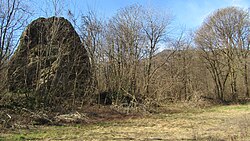
Buttigliera Alta is a town and comune in the Metropolitan City of Turin about 25 kilometres (16 mi) from Turin in the Susa valley in Piedmont, northern Italy. It is not far to Avigliana, of which it once was a part.

Orbassano is a comune (municipality) in the Metropolitan City of Turin in the Italian region Piedmont, located about 13 kilometres southwest of Turin.
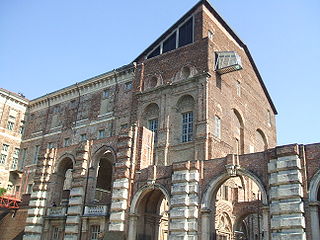
Rivoli is a comune (municipality) established around the 1st century CE, in the Metropolitan City of Turin in the Italian region Piedmont, about 14 kilometres (9 mi) west of Turin. As of 1-1-2017, it had a population of 48,798.

Caselette is a town and comune in the Metropolitan City of Turin, in the Piedmont region of northern Italy.

The Turin Metro is the modern VAL rapid transit system serving Turin. It is operated by Gruppo Torinese Trasporti (GTT), a public company controlled by the municipality of Turin. The system comprises one 15.1-kilometre line with 23 stations connecting Fermi station in Collegno with Piazza Bengasi in Turin, near the border with the municipality of Moncalieri.

Sant'Ambrogio di Torino is a comune (municipality) in the Metropolitan City of Turin in the Italian region Piedmont, located about 25 km west of Turin in the Susa Valley.
Villarbasse is a comune (municipality) in the Metropolitan City of Turin in the Italian region Piedmont, located about 20 kilometres (12 mi) west of Turin.

The 1st Field Artillery Regiment (Mountain) (Italian: 1° Reggimento Artiglieria Terrestre (montagna)) is a field artillery regiment of the Italian Army, specializing in mountain warfare. The regiment is based in Fossano in Piedmont and assigned to the Alpine Brigade "Taurinense". The regiment is the Italian Army's senior mountain artillery regiment as it was formed in 1887 by the Royal Italian Army. In World War I the regiment's groups and batteries served on the Italian front.

The Chisone is a 53-kilometre (33 mi) Italian torrent, which runs through Pragelato, Fenestrelle, Perosa Argentina and Pinerolo in the Metropolitan City of Turin. It is a tributary of the Pellice, which in turn is a tributary of the river Po. Although classified as a torrent, there is no period of the year at which the Chisone runs dry.
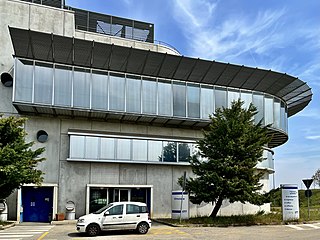
The Gruppo Torinese Trasporti (GTT) is a public benefit corporation responsible for public transportation in the provinces of Alessandria, Cuneo, Asti and the Metropolitan City of Turin. It was created in 2003 from the merge of ATM and SATTI, the latter responsible for railway connection in the province of Turin as well as for the Turin metro. GTT is now wholly owned by the Turin City Hall.

Franco Pappalardo La Rosa is an Italian journalist, literary critic, and writer. He graduated from Turin university. He has lived in Turin since 1963. He contributed to cultural pages of Giornale del Sud, L'Umanità and Gazzetta del Popolo, and to many dictionaries, as Dizionario della Letteratura Italiana, Grande Dizionario Enciclopedico-Appendice 1991 and Dizionario dei Capolavori. Nowadays he contributes to many literary magazines, as Hebenon, Chelsea and L'Indice. He edited the publication of some works written by contemporary Italian writers, as Stefano Jacomuzzi, Giorgio Bàrberi Squarotti, Emanuele Occelli, Francesco Granatiero and Angelo Jacomuzzi. He took part in National and International Conferences on figures and aspects of contemporary poetry and fiction. He edits I Colibrì, fiction library between journalism and literature. He is founding member and member of the Board of Governors of the International Association “Amici di Cesare Pavese”.

The Monte Camulera is a mountain of the Ligurian Prealps, the eastern section of the Ligurian Alps.
The Ligurian Prealps are a mountain range in northwestern Italy. They belong to the Ligurian Alps and are located between the regions of Piemonte and Liguria. Their highest summit is the monte Armetta, at an elevation of 1,739 metres (5,705 ft).

Monte Pietraborga is a mountain in the Cottian Alps, Metropolitan City of Turin in Piedmont, north-western Italy. It is located between the comuni of Trana and Sangano.

Federico Sacco was an Italian geologist, paleontologist and mycologist.

Avigliana Castle is one of the oldest castles in Piedmont. Now just a ruin, it is located in Avigliana at the mouth of the Susa Valley, 25 km from Turin.
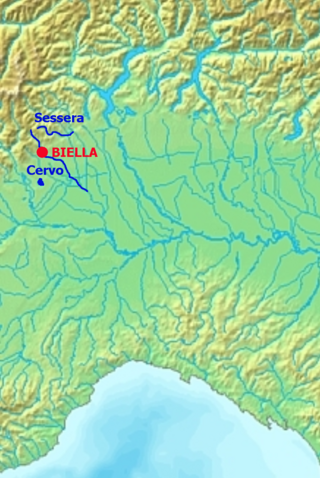
The hydrography of the Biella region, that is, the distribution of surface water in the province of Biella, Italy, falls almost entirely in the two basins of the Cervo and Sessera rivers, both tributaries of the Sesia. Some areas of the southwestern Biella region, on the other hand, are tributaries of the Dora Baltea; the largest natural body of water in the province, Lake Viverone, is also located in this area. In addition to the natural bodies of water, there are several irrigation canals in the plains built mainly to support rice cultivation and some reservoirs built in the foothills. In addition to irrigation, surface water is also used in the Biella area to serve the region's numerous industries and for potable water use, because the area is densely inhabited and groundwater capture is insufficient. Hydroelectric use, on the other hand, is very limited and is substantially confined to the Sessera Valley. The streams of the Biella region can be subject to ruinous floods as well, which have caused numerous damage to property and people over time.
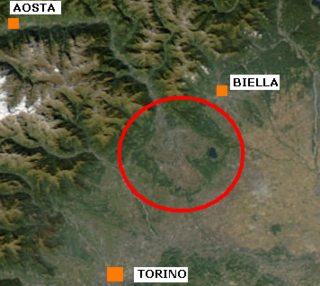
The Ivrea Morainic Amphitheatre is a moraine relief of glacial origin located in the Canavese region. Administratively, it encompasses the metropolitan city of Turin and, more marginally, the province of Biella and the province of Vercelli. It dates back to the Quaternary period and was created by the transport of sediment to the Po Valley that took place during the glaciations by the great glacier that ran through the Dora Baltea valley. With an area of more than 500 km2, it is one of the best-preserved geomorphological units of this type in the world. As an extension, it is surpassed in Italy only by the similar formation surrounding Lake Garda. The name amphitheater, usually given to these geomorphological structures, refers to their characteristic elliptical shape that is noticeable when it is shown as a plan on a map.

Mount Gimont is a mountain 2,646 m above sea level in the Montgenèvre Alps, in the Cottian Alps. It is located on the border between Italy and France (Hautes-Alpes).

The Lakes of Avigliana Natural Park is a nature reserve in Piedmont, Italy. Established in 1980, it covers the area surrounding the eponymous maar lakes and the Mareschi swamp, in the lower Val Susa, between Monte Pirchiriano and the hill of Rivoli.
